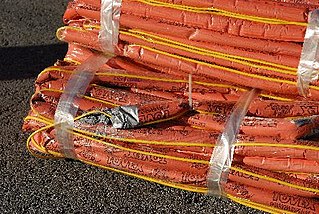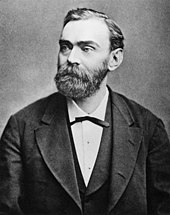
Dynamite is an explosive made of nitroglycerin, sorbents, and stabilizers. It was invented by the Swedish chemist and engineer Alfred Nobel in Geesthacht, Northern Germany, and patented in 1867. It rapidly gained wide-scale use as a more robust alternative to black powder. It allows the use of nitroglycerine's favorable explosive properties while greatly reducing its risk of accidental detonation.

Mining is the extraction of valuable geological materials from the Earth and other astronomical objects. Mining is required to obtain most materials that cannot be grown through agricultural processes, or feasibly created artificially in a laboratory or factory. Ores recovered by mining include metals, coal, oil shale, gemstones, limestone, chalk, dimension stone, rock salt, potash, gravel, and clay. The ore must be a rock or mineral that contains valuable constituent, can be extracted or mined and sold for profit. Mining in a wider sense includes extraction of any non-renewable resource such as petroleum, natural gas, or even water.

Nitroglycerin (NG), also known as trinitroglycerin (TNG), nitro, glyceryl trinitrate (GTN), or 1,2,3-trinitroxypropane, is a dense, colorless, oily, explosive liquid most commonly produced by nitrating glycerol with white fuming nitric acid under conditions appropriate to the formation of the nitric acid ester. Chemically, the substance is an organic nitrate compound rather than a nitro compound, but the traditional name is retained. Invented in 1847 by Ascanio Sobrero, nitroglycerin has been used ever since as an active ingredient in the manufacture of explosives, namely dynamite, and as such it is employed in the construction, demolition, and mining industries. Since the 1880s, it has been used by militaries as an active ingredient and gelatinizer for nitrocellulose in some solid propellants such as cordite and ballistite. It is a major component in double-based smokeless propellants used by reloaders. Combined with nitrocellulose, hundreds of powder combinations are used by rifle, pistol, and shotgun reloaders.

Coke is a grey, hard, and porous coal-based fuel with a high carbon content and few impurities, made by heating coal or oil in the absence of air—a destructive distillation process. It is an important industrial product, used mainly in iron ore smelting, but also as a fuel in stoves and forges when air pollution is a concern.

ANFO ( AN-foh) (or AN/FO, for ammonium nitrate/fuel oil) is a widely used bulk industrial explosive. It consists of 94% porous prilled ammonium nitrate (NH4NO3) (AN), which acts as the oxidizing agent and absorbent for the fuel, and 6% number 2 fuel oil (FO). The use of ANFO originated in the 1950s.

Coal mining is the process of extracting coal from the ground or from a mine. Coal is valued for its energy content and since the 1880s has been widely used to generate electricity. Steel and cement industries use coal as a fuel for extraction of iron from iron ore and for cement production. In the United Kingdom and South Africa, a coal mine and its structures are a colliery, a coal mine is called a 'pit', and the above-ground structures are a 'pit head'. In Australia, "colliery" generally refers to an underground coal mine.
Primacord is a brand of detonating cord used in blasting. The registered trademark Primacord was originally owned by the Ensign-Bickford Company; Ensign-Bickford sold the trademark to Dyno Nobel in 2003, who manufacture it in their Graham, Kentucky factory. The name is also used as a genericized trademark for any detonating cord.
Eastman Chemical Company is an American company primarily involved in the chemical industry. Once a subsidiary of Kodak, today it is an independent global specialty materials company that produces a broad range of advanced materials, chemicals and fibers for everyday purposes. Founded in 1920 and based in Kingsport, Tennessee, the company now has more than 50 manufacturing sites worldwide and employs approximately 14,000 people.

Orica Limited is an Australian-based multinational corporation that is one of the world's largest providers of commercial explosives and blasting systems to the mining, quarrying, oil and gas, and construction markets, a supplier of sodium cyanide for gold extraction, and a specialist provider of ground support services in mining and tunnelling.

The Ensign-Bickford Aerospace & Defense Company is a manufacturer of hardware and energetic systems for use in spacecraft, military, and industrial applications. It is a wholly owned subsidiary of Ensign-Bickford Industries.
Underground coal gasification (UCG) is an industrial process which converts coal into product gas. UCG is an in-situ gasification process, carried out in non-mined coal seams using injection of oxidants and steam. The product gas is brought to the surface through production wells drilled from the surface.
Redbank Power Station is a biomass power station located in Warkworth, within the Hunter Region of New South Wales, Australia. The station is currently awaiting a restart of operations after converting from its original use as a coal-fired power station. Redbank is unique for its utilisation of circulating fluidised bed technology, the only generator of its kind in Australia. Upon re-fire, the station will operate using 100% biomass at a capacity of 151MW of electricity.
John Marlay is chairman of ASX200 professional infrastructure and environmental services company, Cardno Limited (ASX:CDD). Prior to his appointment as chairman of Cardno in August 2012, Marlay has served as a director on the Cardno Board since November 2011.
Melvin Alonzo Cook was an American chemist, most known from his work in explosives, including the development of shaped charges and slurry explosives. Cook was a member of the Church of Jesus Christ of Latter-day Saints.
Incitec Pivot Ltd. is an Australian multinational corporation that manufactures fertiliser, explosives chemicals, and mining service. Incitec Pivot is the largest supplier of fertilisers in Australia; the largest supplier of explosives products and services in North America; and the second largest supplier of explosives products and services in the world. The company began trading on the ASX on 30 July 2003 having been formed as the result of a merger between Incitec Fertilizers and the Pivot group, and substantially expanded with the acquisition of Southern Cross Fertilisers in 2006 and Dyno Nobel in 2008.
Explosive materials are produced in numerous physical forms for their use in mining, engineering, or military applications. The different physical forms and fabrication methods are grouped together in several use forms of explosives.

Linc Energy was an Australian energy company that specialised in coal-based synthetic fuel production, as well as conventional oil and gas production. It was engaged in development and commercialisation of proprietary underground coal gasification technology. Produced gas was used for production of synthetic fuel through gas-to-liquid technology, and was also used for power generation. The company had its headquarters in Brisbane, Queensland.
The safety fuse is a type of fuse invented and patented by English inventor William Bickford in 1831. Originally it consisted of a "tube" of gunpowder surrounded by a waterproofed varnished jute "rope." It replaced earlier and less reliable methods of igniting gunpowder blasting charges which had caused many injuries and deaths in the mining industry. The safety fuse burns at a rate of typically about 30 seconds per foot.
The Darlot-Centenary Gold Mine is a gold mine located 58 km east of Leinster, Western Australia.

A water-gel explosive is a fuel sensitized explosive mixture consisting of an aqueous ammonium nitrate solution that acts as the oxidizer. Water gels that are cap-insensitive are referred to under United States safety regulations as blasting agents. Water gel explosives have a jelly-like consistency and come in sausage-like packing stapled shut on both sides.













